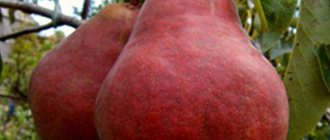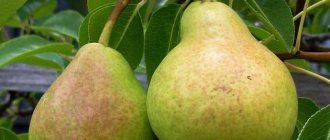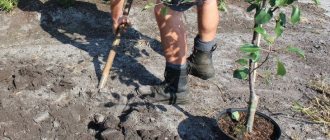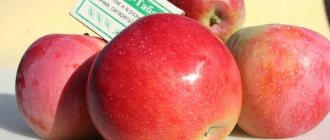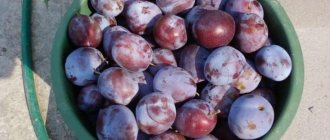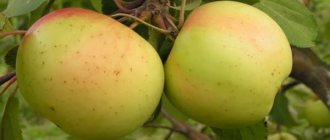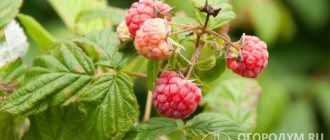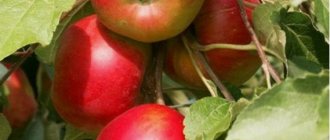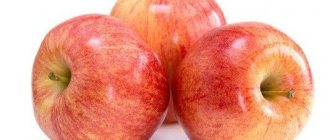Sweet autumn pear.
Description of the variety
The Autumn Sweet pear variety is a folk selection and, due to its winter hardiness, is grown in the Central region, Western Siberia and the Urals. But unlike varieties that are grown in cold regions, Autumn Sweet has very tasty and sweet fruits weighing 140-150 grams.
Characteristics of wood
A medium-sized crop, up to 3.5-4 meters high with a wide-pyramidal, sparse crown. Its growth force is small, as is its development rate. The variety is grafted onto wild pear and quince to increase winter hardiness and immunity.
Description of fruits
Autumn sweet.
The pears are broadly pear-shaped, slanted towards the stalk, the skin is light yellow with brown spots and subcutaneous dots. The weight of one fruit is 140-150 grams, individual specimens can reach 250 grams.
The pulp is white, very juicy, aromatic, oily, with a small number of stony spots. The taste is sweet and sour, dessert.
In memory of Zhegalov
The tree is medium-sized, the crown is not very dense, oval-round. The fruits are greenish-yellow, medium in size, obovate or doubly conical in shape. The skin is thin, smooth, of medium density. The pulp is whitish or light yellow, very juicy, medium-grained, oily. A medium-yielding variety, winter-hardy, resistant to major fungal diseases of pear.
| Entry into fruiting | Tree height (m) | Fruit weight (g) | Harvest | Shelf life (days) |
| for 3-4 years | 3-5 | 120-130 | second half of September | 100-120 |
Reviews
Sweet autumn pear grows in our garden. The tree is low and easy to care for. It is resistant to scab. Ripe pears are beautiful, tasty and aromatic. We use them fresh and make compote, jam, and dried fruits for the winter.
Maria
Tupolevo
We have several pears growing on our plot, our Sweet Autumn pear has never frozen, the fruits are very tasty and sweet. We collect them solid in mid-September and store them on the balcony.
Matvey
Fire
In the Sverdlovsk region, the Autumn sweet pear grows well and does not freeze. I feed it and water it every year. Pears are very sweet and aromatic. I collect 5-6 buckets of fruit from a tree.
Gregory
Zarechny
In memory of Yakovlev
The tree is low-growing, the crown is medium dense, rounded. The fruits are light yellow with a faint pink blush, medium size, broadly pear-shaped. The skin is thin, shiny, semi-oily. The pulp is creamy white, juicy, semi-oily. Winter-hardy, high-yielding variety, resistant to diseases.
| Entry into fruiting | Tree height (m) | Fruit weight (g) | Harvest | Shelf life (days) |
| for 3-4 years | 2-3 | 120 | September October | up to 120 |
Landing
Sweet autumn pear adapts well to different types of soil, but for healthy development it is important to properly prepare the hole and plant the seedling. Location also plays an important role in the development of the variety. Useful information and instructions for planting the Autumn sweet pear variety can be found in the articles selected below.
How to plant a pear tree correctly
At what distance to plant pears?
How to choose pear seedlings
How to replant a pear
The best varieties of autumn pears depending on the region
Autumn varieties that require heat and sun are cultivated in the south of Russia and Ukraine, drought-resistant varieties in the Far East and the south of the Black Earth Region, and frost-resistant varieties in Siberia, Transbaikalia and the North-West of our country.
Varieties of autumn pears for the Moscow region
For the Moscow region, early-fruiting and frost-resistant varieties that are undemanding to soil fertility are good. They performed best on Moscow private plots:
- Marble;
- Tyutchevskaya;
- In memory of Yakovlev;
- Veles;
- Simply Maria;
- Forest beauty.
Of the majority of late-ripening varieties, Pamyat Zhegalova and Dekabrinka stand out.
Pears ripening in autumn in the middle zone and Chernozem region
In the Black Earth Region and the middle zone, early-ripening and late varieties of autumn pears grow equally well. With sufficient moisture and regular fertilizing, late-ripening varieties have a high yield. Among the early autumn varieties, gardeners choose Tyutchevskaya and Pamyati Yakovlev. The following have proven themselves well in the Black Earth Region:
- Selyanka;
- Conference;
- Autumn Dream;
- Muscovite;
- Irista;
- Yeseninskaya;
- Alyonushka;
- Yakovlev's favorite.
Autumn pear varieties suitable for Siberia and the Far East
The unstable Far Eastern climate and severe frosts of Siberia can withstand varieties that can withstand temperatures down to -30°C. These include:
- Bashkir autumn;
- Parshin's memory;
- Hanging;
- Svarog;
- Granddaughter;
- Sverdlovsk;
- Karataevskaya;
- Long awaited.
Memory Parshina pear is suitable for growing in Siberia and the Far East
The varietal characteristics of these pears make it possible to obtain the maximum harvest in a relatively short summer.
Autumn pears for Ukraine
Autumn pear varieties, undemanding to watering and easily withstanding heat and dry winds, with proper care give an excellent harvest in the southern climate of Ukraine. These include:
- Conference;
- Perun;
- Williams;
- Selyanka;
- Alyonushka;
- Veles;
- Anniversary Korneeva.
Williams pear is suitable for growing in Ukraine
Novosadovskaya, Rassvet, Tyutchevskaya, Chernomorskaya Yantarnaya are the best varieties in Ukraine for processing and fresh consumption.
Varieties of autumn pears for Belarus
The Belarusian land has long been conquered by pear varieties:
- Tatiana;
- Simply Maria;
- Autumn Dream;
- Hope of the steppe;
- Hanging;
- Kupava;
- Larinskaya.
In temperate climates, Alyonushka, Dessertnaya and Dekabrinka bear fruit without problems.
Care
Trees of this variety are fastidious to care for and will require a lot of attention from gardeners. To obtain good harvests, it is enough to carry out basic agrotechnical measures on time, but to do it correctly. It is important to water the pear tree in a timely manner and fertilize it according to schedule. More useful materials on the topic of agricultural technology of the Autumn sweet variety can be found in the selection of articles listed below.
How to care for a pear Pruning a pear Pruning a columnar pear Treating a pear from diseases and pests Feeding a pear How to water a pear
Varieties for planting in gardens of the Moscow region
The climate of the Moscow region is not suitable for every type of fruit tree. Several varieties are recognized as “suppliers” of the best pears for the Moscow region. They are also suitable for the Black Earth Region.
Elegant Efimova
Winter-hardy, hybrid fruit with good immunity from diseases. Created in the 1930s by the Soviet breeder V. A. Efimov for the Moscow region and regions with a similar climate. The tree is tall, dense, pyramidal in outline, with small leaves and dark brown bark. Pears are of medium parameters, up to 125 g. But they look elegant: canonical in shape, with a thin skin that organically combines red orangishness and greenery. However, in summer, dark spots may appear on the surface. Pears are tender, juicy, sweet in taste with a delicious aroma. They ripen at the border between August and September. They overripe almost instantly, so you need to monitor the process and remove them when they are a little hard.
Vera yellow
Tall pyramidal trees with skyward branches and brown-brown bark. The skin of the pear is yellow - it becomes so by mid-September. Fruits grow in clusters of two or three. Sweet, aromatic, with fleshy medium-grained pulp. One of the good varieties for the Moscow region: frost-resistant, easy to care for. However, fruiting is cyclical: every two to three years, a decline in yield and the shrinking of fruits are replaced by restoration of conditions.
Fabulous
Hybrid variety created for the Moscow region. The trees are of medium height but highly productive. The name is given as a description of a pear with a classically regular shape. The ripe fruit is reddish-yellow on one half and greenish on the other. The pulp is medium-grained, snow-white, fleshy. There are five or six pieces per kilogram. Fruit trees have good immunity against frost, pests and transplants.
Tenderness
This hybrid can also be planted by gardeners in the Moscow region and surrounding regions. A tree of medium height, with a thin crown. Pros: good resistance to frost and disease, unpretentiousness, stable yields. The only “requirement” is more sun. Pears have a classic shape and coarse-grained structure, large (on average five pears per kg), melting in the mouth, juicy, exuding a delicious aroma. They grow three in a rosette and remain on the branches until frost.
Prominent or Lumpy
Medium-tall plant with a pyramidal crown. A variety with medium-sized fruits and a classic shape, which appear in the fifth season. The skin is dense, red in color. The pulp is coarse-grained, snow-white, sweet, juicy, aromatic. The harvest in the Moscow region is harvested by mid-August, while the fruits are slightly unripe. They will last for several months. Due to the active growth of the branches, annual autumn pruning is required, otherwise the pears will be small.
Diseases and pests
The tree has good resistance to scab and pest attacks. Spring preventive treatments increase the tree's resistance. You can read about all preventive measures and protection of the Autumn sweet pear using the links below.
Dangerous Pear Pests
Pears often suffer from pests, they affect the leaves, bark and fruits.
In this article, we have selected 11 of the most harmful insects that harm pear trees, and also ways to destroy them.
Diseases of pear trees
To get what they cherish, gardeners have to work hard, and the reason for this is pear diseases.
Read about 19 common pear diseases and how to combat them.
Autumn
The ripening period for autumn pear varieties is September-October. The fruits are distinguished by denser and juicier pulp, which allows them to be stored for quite a long time.
Otradnenskaya
Medium-sized tree of standard type. The trees are spreading, medium-thick with dark gray bark. They have a weak shoot-forming ability. The branches are of medium length, slightly curved.
The weight of the fruit is about 100 grams. Pears are one-dimensional, oblong, with a slightly ribbed surface. The main color is green with a rich red blush. The pulp has a delicate consistency, sweet and sour, with a pleasant characteristic aroma.
Important! Otradnenskaya is partially self-fertile. Therefore, it is necessary to plant pollinators next to it.
Otradnenskaya is valued for its resistance to scab and adverse weather conditions. The shelf life of fruits when harvested correctly is 3-4 months. During storage, the taste of the fruit improves significantly.
Cheremshina
An ancient variety of Ukrainian selection. It begins to actively bear fruit in the 5th-6th year of cultivation. Fruit harvesting, depending on weather conditions, is carried out from October to November.
The pears are quite large, the weight of some specimens can reach 250 grams. The color of the skin is rich yellow with a transition to orange. The shelf life of fruits when picked correctly is up to 5 months.
Duchess
One of the best dessert varieties. It is a kind of standard of taste. The trees are medium-sized, with a wide asymmetrical crown. Branches of medium length, arched. Flowering later, long lasting. Duchess retains excellent fruit set.
The fruits are oblong and quite large. The skin is glossy, smooth with a very pleasant smell. When picked, the main color of pears is green; after ripening, it changes to yellow. The pulp is slightly yellowish, very juicy, with excellent taste characteristics.
The tasting score of the fruit is close to the maximum score of 5 points. Due to their high dry matter content, Duchess pears are often used for drying and various types of canning. Depending on weather conditions, fruit harvesting begins at the end of August and continues until the end of September. The shelf life if collected in a timely manner reaches 1.5 months.
Duchess is completely self-sterile. He definitely needs pollinators.
In general, the variety is undemanding to growing conditions, but the highest yield can be achieved on fertile soils of medium density.
Attention! Due to its low winter hardiness, Duchess is recommended for cultivation in the southern regions.
Bere
Dessert pear Bere was created as a random seedling in France in 1820 in Boulogne-sur-Mer, by gardener M. Bonnet. Its French name was a tribute to the director of the Luxembourg Gardens, M. Hardy (Berre Hardy).
These are vigorous growing trees and are a good pollinator for some other varieties. The fruits are oval-shaped with a yellow-green skin and a golden tan. The pulp of the Bere Pear has a pungent aftertaste and is extremely juicy. The fruits can be collected in mid-September, suitable for desserts and canned food.
Advantages of the variety:
- trees are very resistant to frost;
- not susceptible to scab;
- resistant to bacterial blight of fruit crops.
In addition to those described above, there are other highly productive autumn varieties, for example, Bere Bosc. Its value lies in its excellent taste, which allows it to be used as an original dessert and high, stable yield.
Clapp's Favorite
The Clapp's Favorite pear is known as Clapp's Favorite, recognized as one of the most valuable varieties. Its name was given by the American farmer Thaddeus Clapp, who was engaged in crossing pear trees. Clapp developed the Clapp variety in 1840 in present-day Boston from Fleming and Pear Williams. The variety has become popular.
This is interesting! The variety's creator, Farmer Clapp, received a financial offer of $1,000 to change the variety's name to Marshall P. Wilder. Clapp did not accept the tempting offer, and to this day his name is praised all over the world, and in the Dorchester district of Boston, where the farmer lived, there is a monument.
Klappa pear is a dessert variety that is best eaten raw; the fruit has very tasty, juicy and buttery pulp. Large and very large fruits of yellow-green color with a slight blush ripen in August-September. The variety does not have any special requirements for soil or care.
Disadvantages of the variety:
- strong growth,
- average resistance to diseases (scab and rust),
- the young tree is not very resistant to frost and requires protection in winter,
- irregular fruiting.
Williams (Williams)
An ancient variety of this fruit tree, created in 1750 in England, is extremely popular to this day in the world. Created by a teacher named Stair, but owes its popularity to Farmer Williams, from whom it received the name. Some researchers associate the Williams pear with the pear tree, already known in the Middle Ages when, according to legend, St. Francis of Paola gave his seeds as a gift to King Louis XI.
This exceptionally disease-resistant variety requires virtually no soil conditions - it can grow on poorly fertile soil and recover after freezing.
The fruits ripen in September, large to medium-sized, with greenish-yellow skin with slightly rusty spots or blush. Delicious, sweet, slightly spicy pears are ideal for eating raw, canning, and drying.
Conference
The popular Pear Conference pear variety was created in the second half of the 19th century, bred by an English gardener named Rivers, working in Subridgeworth. These are exceptionally fast-growing trees; after an initial intensive period, their growth rate decreases. They bear fruit early, usually 3-4 years after planting the trees. Pears are not susceptible to diseases, including the common scab.
The variety has soil requirements - it grows poorly on too light or heavy, wet soils, which contribute to the death of plants. The fruits ripen at the turn of September-October and have a matte, greenish skin with brown spots. Pears are large, juicy, tender, slightly aromatic, and can be stored in a cool place until April.
General Leclerc
The General Leclerc pear variety comes from France, bred in 1950 by A. Nobloza. It has tasty, large fruits with a characteristic skin covered almost entirely with brown and yellow reddish-brown tan. The fruits are ideal for eating raw in early October, when they are fully ripe.
General Leclerc pear trees are a unique, rewarding variety for professional and amateur cultivation. They grow extremely quickly within 3-4 years after planting. The harvest is usually regular and abundant. General Leclerc loves sunny locations with fertile, permeable soil rich in organic matter. The variety is moderately resistant to frost; in case of extremely low temperatures it must be protected from freezing.
Decanque du Comis
The variety achieved success in 1840. The variety was created in France, in 1894 it was awarded the title “Best Pears in the World”, conquering other European countries and the United States. It has an excellent taste of raw fruits, suitable for desserts and cakes due to its soft, yellowish-white, juicy, aromatic pulp. Large fruits can be stored at low temperatures after late harvest.
The pear is suitable for growing on sandy loam soils in sunny positions. The disadvantage of this variety is late fruiting. On trees, fruits can be expected only after 6-10 years. The variety is resistant to scab; young trees must be protected from frost.
Veles pear
The Veles pear is capable of self-pollination, but to improve productivity, the following species are planted nearby: Chizhovskaya, Rogneda, Voskresenskaya large, Severyanka, Prosto Maria. They are excellent pollinators.
Fruiting occurs 6-7 years after planting. Pears ripen in late summer and early autumn.
Description of the tree
The crop is medium-sized, grows up to 4 m. The crown is spreading in the early stages of development. As the plant matures, it takes on a pyramidal shape. The foliage is average. The branches are thick and long, curved. The shoots are brownish-brown. The leaves are dark green and small. The edges are finely serrated. Their surface is smooth.
Description of the fruit
Pear-shaped. The fruits are wide, non-ribbed. The average weight is 170 g, larger fruits reach 200 g. The skin is smooth and shiny. The color is light green with a pale blush at the stage of technical maturity. At the stage of full ripening - yellow with a reddish tint. The pulp is juicy, semi-oily, medium density, creamy. The taste is sweet, with slight sourness.
